Abstract
The aim of this study was to determine the variability of measurements of ankle and brachial systolic pressures and ankle brachial ratios in order to assess their suitability for use in epidemiological studies of arterial disease in the lower limbs. Thirty-six subjects had repeat measurements taken by four observers on two separate days using a Doppler probe and random zero sphygmomanometer. The variability in the measurement of ankle systolic pressure was comparable to that for brachial systolic pressure. The 95% confidence limits of one measurement of the ankle brachial ratio was estimated to be +/- 16%, reducing to +/- 10% for the mean of four measurements taken by two observers on two days. Analysis of variance indicated that the variability in the measurement of ankle brachial ratios attributable to observers, days, timing of measurements on the same day, and repeat measurements was considerably less than the "biological" variability between subjects and between legs. These results suggest that repeatability of the ankle brachial ratio is such that a single measurement is suitable for most epidemiological studies of atherosclerotic peripheral arterial disease.
Full text
PDF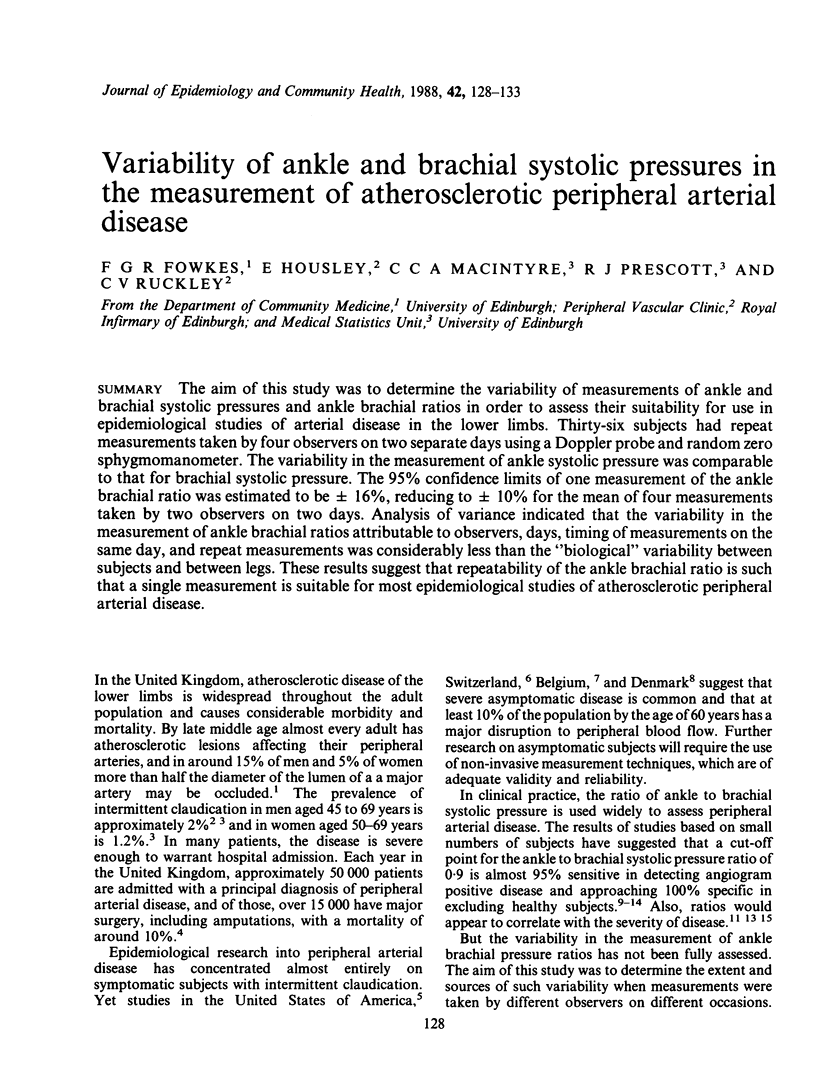
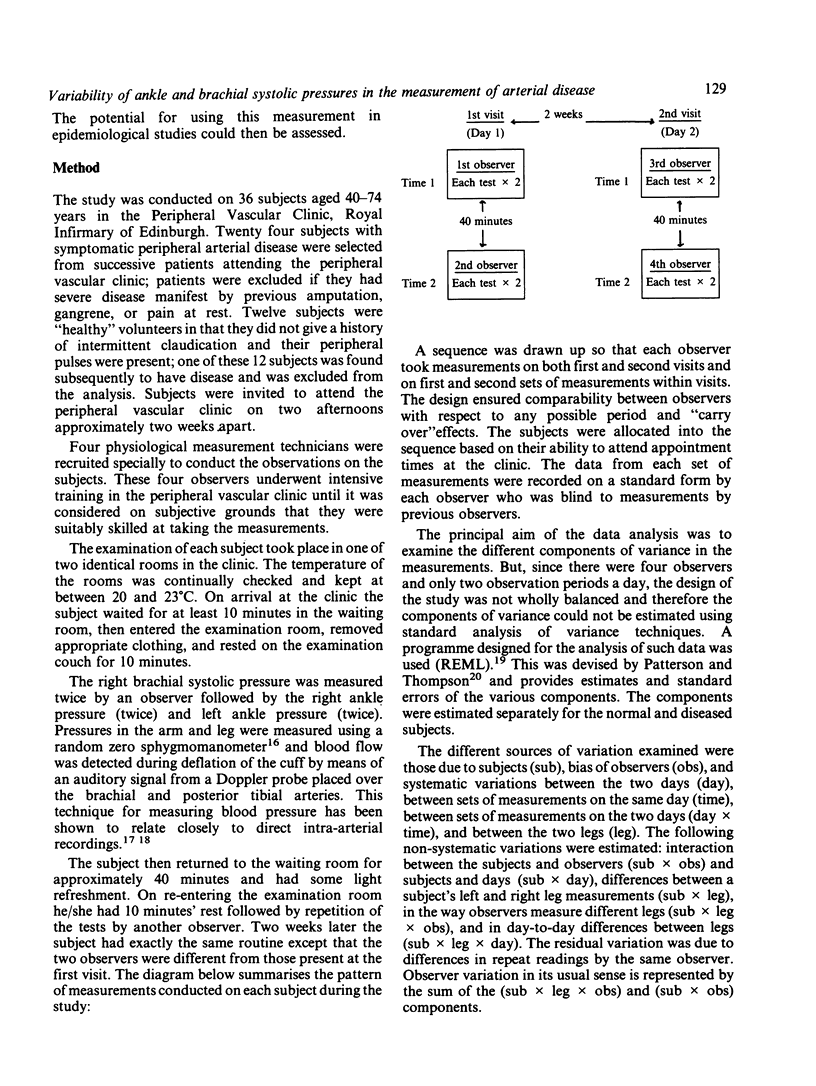
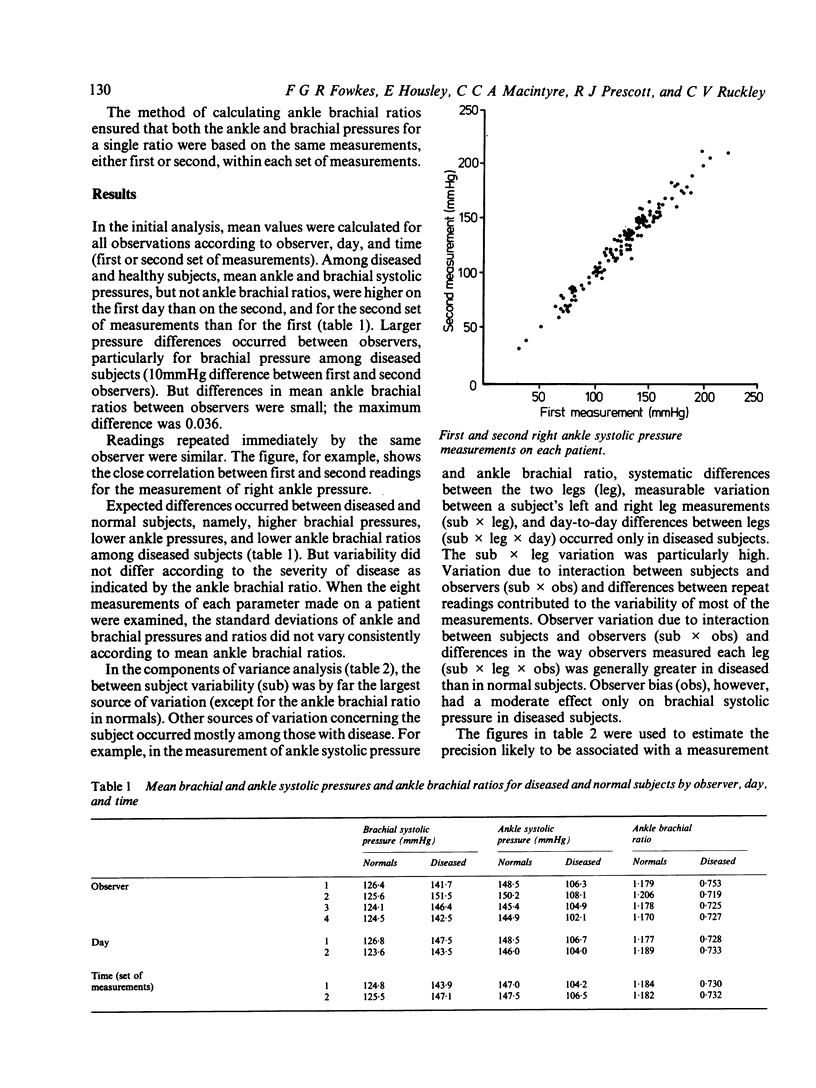
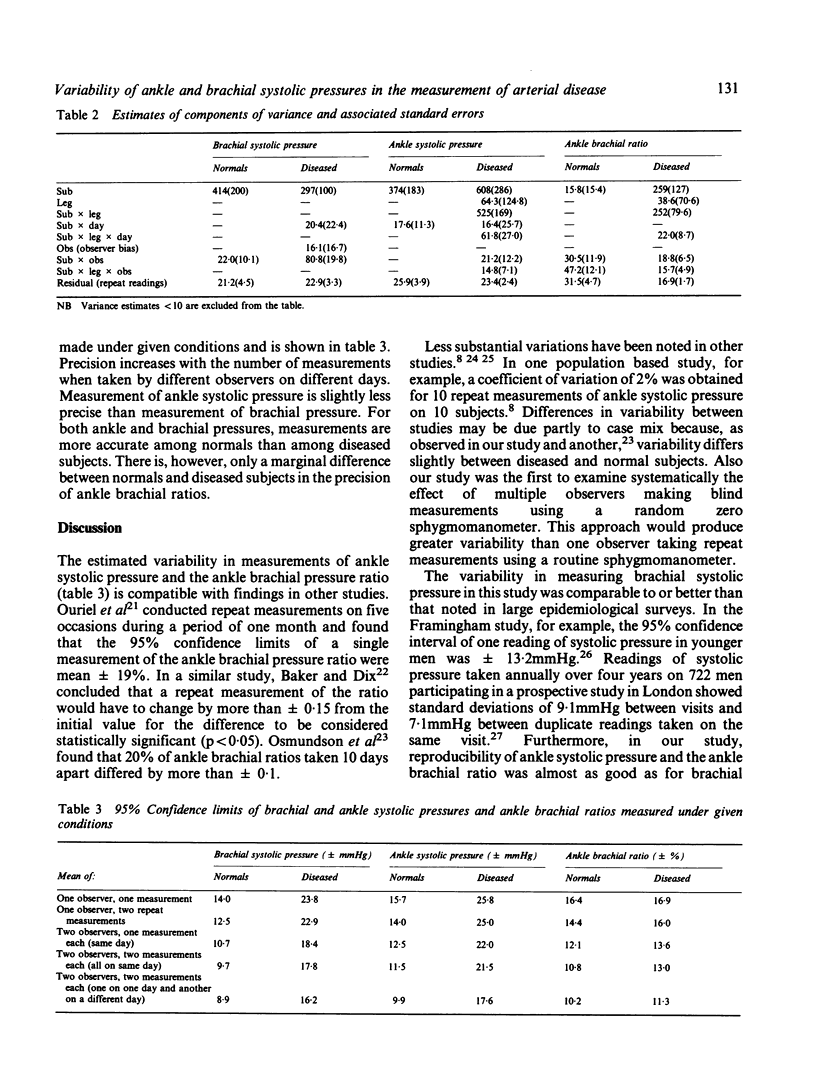
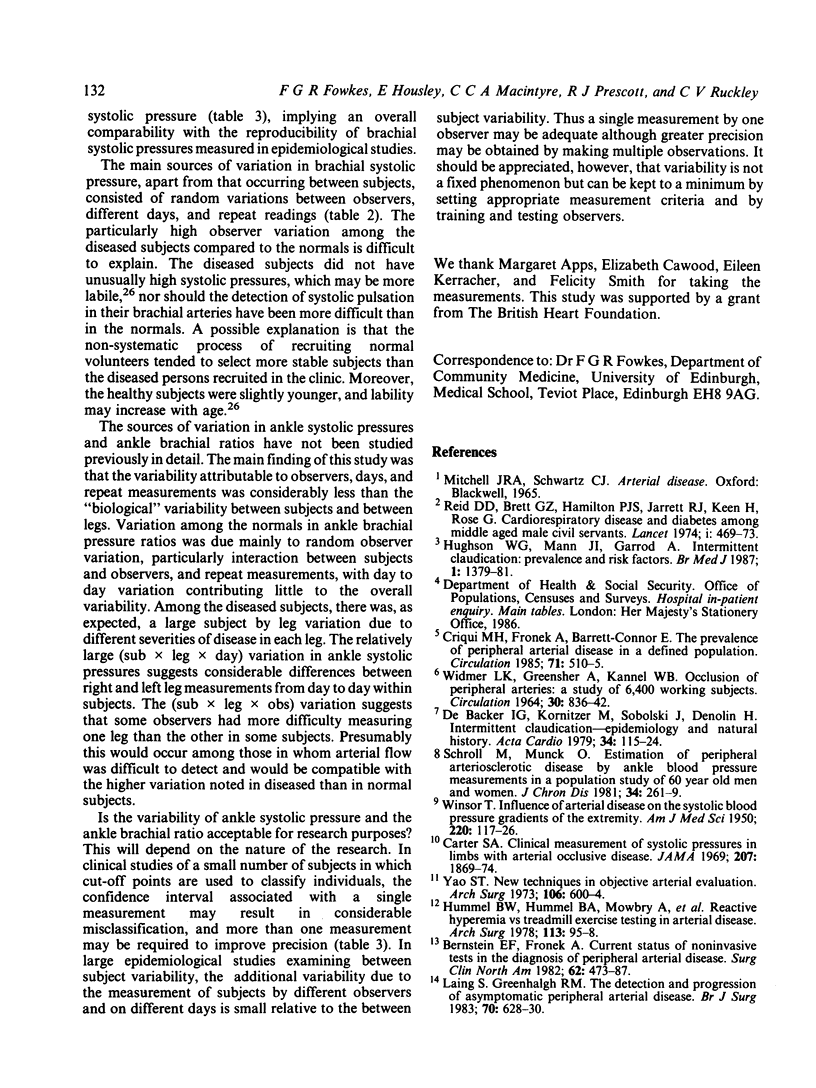
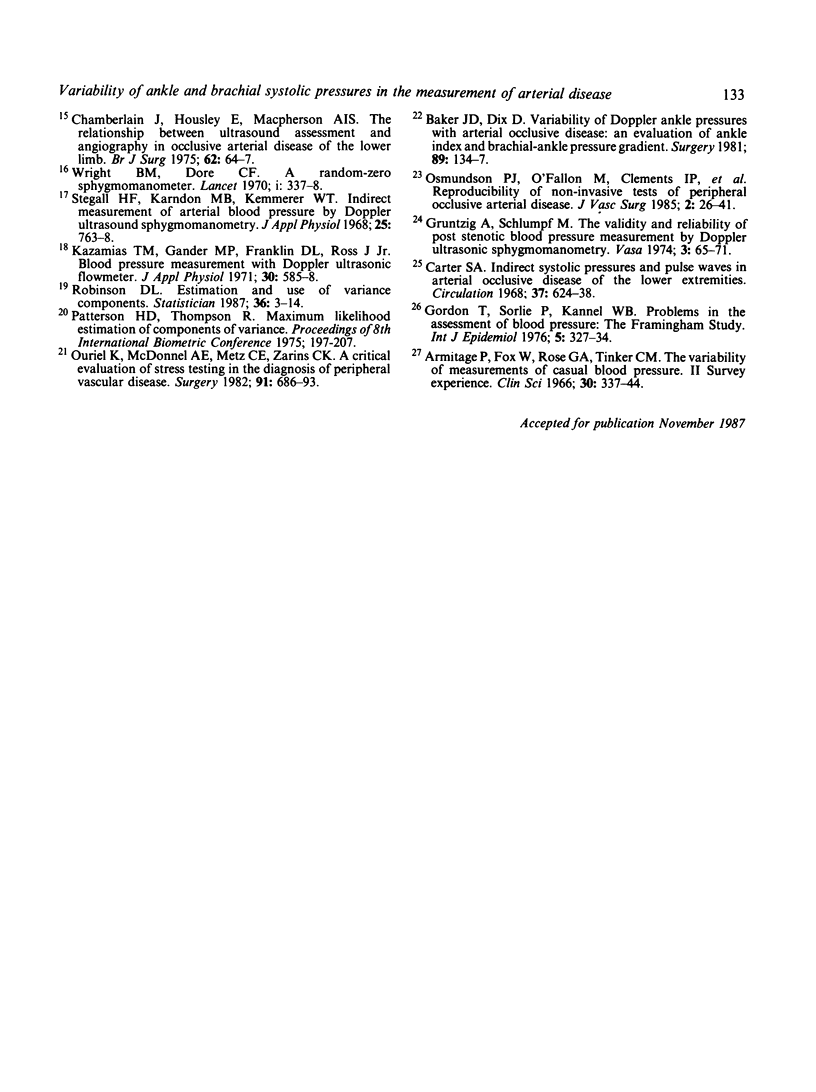
Selected References
These references are in PubMed. This may not be the complete list of references from this article.
- Armitage P., Fox W., Rose G. A., Tinker C. M. The variability of measurements of casual blood pressure. II. Survey experience. Clin Sci. 1966 Apr;30(2):337–344. [PubMed] [Google Scholar]
- Baker J. D., Dix D. E. Variability of Doppler ankle pressures with arterial occlusive disease: an evaluation of ankle index and brachial-ankle pressure gradient. Surgery. 1981 Jan;89(1):134–137. [PubMed] [Google Scholar]
- Bernstein E. F., Fronek A. Current status of noninvasive tests in the diagnosis of peripheral arterial disease. Surg Clin North Am. 1982 Jun;62(3):473–487. doi: 10.1016/s0039-6109(16)42739-8. [DOI] [PubMed] [Google Scholar]
- Carter S. A. Clinical measurement of systolic pressures in limbs with arterial occlusive disease. JAMA. 1969 Mar 10;207(10):1869–1874. [PubMed] [Google Scholar]
- Carter S. A. Indirect systolic pressures and pulse waves in arterial occlusive diseases of the lower extremities. Circulation. 1968 Apr;37(4):624–637. doi: 10.1161/01.cir.37.4.624. [DOI] [PubMed] [Google Scholar]
- Chamberlain J., Housley E., Macpherson A. I. The relationship between ultrasound assessment and angiography in occlusive arterial disease of the lower limb. Br J Surg. 1975 Jan;62(1):64–67. doi: 10.1002/bjs.1800620115. [DOI] [PubMed] [Google Scholar]
- Criqui M. H., Fronek A., Barrett-Connor E., Klauber M. R., Gabriel S., Goodman D. The prevalence of peripheral arterial disease in a defined population. Circulation. 1985 Mar;71(3):510–515. doi: 10.1161/01.cir.71.3.510. [DOI] [PubMed] [Google Scholar]
- De Backer G., Kornitzer M., Sobolski J., Denolin H. Intermittent claudication--epidemiology and natural history. Acta Cardiol. 1979;34(3):115–124. [PubMed] [Google Scholar]
- Gordon T., Sorlie P., Kannel W. B. Problems in the assessment of blood pressure: the Framingham Study. Int J Epidemiol. 1976 Dec;5(4):327–334. doi: 10.1093/ije/5.4.327. [DOI] [PubMed] [Google Scholar]
- Grüntzig A., Schlumpf M. The validity and reliability of post-stenotic blood pressure measurement by Doppler ultrasonic sphygmomanometry. Vasa. 1974;3(1):65–71. [PubMed] [Google Scholar]
- Hughson W. G., Mann J. I., Garrod A. Intermittent claudication: prevalence and risk factors. Br Med J. 1978 May 27;1(6124):1379–1381. doi: 10.1136/bmj.1.6124.1379. [DOI] [PMC free article] [PubMed] [Google Scholar]
- Hummel B. W., Hummel B. A., Mowbry A., Maixner W., Barnes R. W. Reactive hyperemia vs treadmill exercise testing in arterial disease. Arch Surg. 1978 Jan;113(1):95–98. doi: 10.1001/archsurg.1978.01370130097019. [DOI] [PubMed] [Google Scholar]
- Kazamias T. M., Gander M. P., Franklin D. L., Ross J., Jr Blood pressure measurement with Doppler ultrasonic flowmeter. J Appl Physiol. 1971 Apr;30(4):585–588. doi: 10.1152/jappl.1971.30.4.585. [DOI] [PubMed] [Google Scholar]
- Laing S., Greenhalgh R. M. The detection and progression of asymptomatic peripheral arterial disease. Br J Surg. 1983 Oct;70(10):628–630. doi: 10.1002/bjs.1800701017. [DOI] [PubMed] [Google Scholar]
- O'Donnell T. F., Jr, Callow A. D., Scott G., Shepard A. D., Heggerick P., Mackey W. C. Ultrasound characteristics of recurrent carotid disease: hypothesis explaining the low incidence of symptomatic recurrence. J Vasc Surg. 1985 Jan;2(1):26–41. [PubMed] [Google Scholar]
- Ouriel K., McDonnell A. E., Metz C. E., Zarins C. K. Critical evaluation of stress testing in the diagnosis of peripheral vascular disease. Surgery. 1982 Jun;91(6):686–693. [PubMed] [Google Scholar]
- Reid D. D., Brett G. Z., Hamilton P. J., Jarrett R. J., Keen H., Rose G. Cardiorespiratory disease and diabetes among middle-aged male Civil Servants. A study of screening and intervention. Lancet. 1974 Mar 23;1(7856):469–473. doi: 10.1016/s0140-6736(74)92783-4. [DOI] [PubMed] [Google Scholar]
- Schroll M., Munck O. Estimation of peripheral arteriosclerotic disease by ankle blood pressure measurements in a population study of 60-year-old men and women. J Chronic Dis. 1981;34(6):261–269. doi: 10.1016/0021-9681(81)90031-x. [DOI] [PubMed] [Google Scholar]
- WIDMER L. K., GREENSHER A., KANNEL W. B. OCCLUSION OF PERIPHERAL ARTERIES: A STUDY OF 6,400 WORKING SUBJECTS. Circulation. 1964 Dec;30:836–852. doi: 10.1161/01.cir.30.6.836. [DOI] [PubMed] [Google Scholar]
- WINSOR T. Influence of arterial disease on the systolic blood pressure gradients of the extremity. Am J Med Sci. 1950 Aug;220(2):117–126. doi: 10.1097/00000441-195008000-00001. [DOI] [PubMed] [Google Scholar]
- Wright B. M., Dore C. F. A random-zero sphygmomanometer. Lancet. 1970 Feb 14;1(7642):337–338. doi: 10.1016/s0140-6736(70)90709-9. [DOI] [PubMed] [Google Scholar]
- Yao J. S. New techniques in objective arterial evaluation. Arch Surg. 1973 Apr;106(4):600–604. doi: 10.1001/archsurg.1973.01350160212038. [DOI] [PubMed] [Google Scholar]


